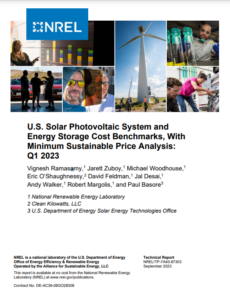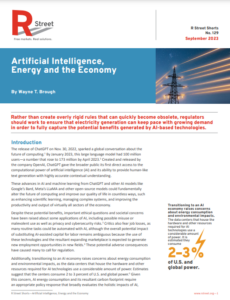The OurEnergyLibrary aggregates and indexes publicly available fact sheets, journal articles, reports, studies, and other publications on U.S. energy topics. It is updated every week to include the most recent energy resources from academia, government, industry, non-profits, think tanks, and trade associations. Suggest a resource by emailing us at info@ourenergypolicy.org.
Resource Library
Liftoff reports describe the market opportunity, current challenges, and potential solutions for the commercialization of interdependent clean energy technologies. Liftoff reports are an ongoing, DOE-led effort to engage directly with energy communities and the private sector across the entire clean-energy landscape. Their goal is to catalyze rapid and coordinated action across the full technology value chain.
This report is meant for a diverse audience of stakeholders who can help accelerate liftoff for virtual power plants (VPPs). For the audience unfamiliar with VPPs, this report aims to build foundational understanding of their value proposition and the associated business models and technology …
View Full ResourceSeveral recent developments in administrative law—namely the Supreme Court’s embrace of the major questions doctrine and decision to hear a case asking it to overrule or clarify Chevron deference—have left federal agencies uncertain about how regulations will fare in litigation. Agencies adapting to this uncertainty may want to pay closer attention to recent case law on administrative severability, which allows a court to sever the invalid portion of a rule while leaving the rest intact.
This recent case law indicates that boilerplate severability clauses may not convince a court to find a rule severable. Instead, to improve the chances that …
View Full ResourceBidirectional charging has significant potential in transforming how consumers view and use their electric vehicles (EVs). Bidirectional charging allows EVs to become a flexible resource for power systems. At high rates of adoption, EVs can have significant impacts on coincident- system and feeder-level peaks. To mitigate these load impacts, utilities and EV charging site hosts often utilize a variety of managed charging solutions to optimize EV charging. As part of the continuum of managed charging solutions, bidirectional charging creates an opportunity for EVs to be used as an energy resource and to discharge back to the grid. Bidirectional charging’s ability …
View Full ResourceFrom 2020 to 2023, the City of Milwaukee participated as a partner in the Better Buildings Workforce Accelerator (BBWA). The BBWA is a Department of Energy (DOE) initiative seeking to raise the level of building science and energy efficiency knowledge in the nation’s building-related workforce. Through the BBWA, DOE engaged industry partners in activities that build interest and awareness, streamline pathways, and improve skills for people pursuing green building careers.…
View Full ResourceThe U.S. Department of Energy’s (DOE’s) Solar Energy Technologies Office (SETO) aims to accelerate the advancement and deployment of solar technology in support of an equitable transition to a decarbonized economy no later than 2050, starting with a decarbonized power sector by 2035. Its approach to achieving this goal includes driving innovations in technology, hardware, and soft cost reductions to make solar even more affordable and accessible for all. As part of this effort, SETO tracks solar cost trends to focus its research and development (R&D) investments on the highest-impact activities.
The National Renewable Energy Laboratory (NREL) publishes benchmark reports …
View Full ResourceClean energy is quickly becoming one of the largest industries in the U.S. Across the economy, public and private investment in decarbonization is growing—accelerating manufacturing and the adoption of the technologies needed for clean electricity and transportation, building electrification, low-emission industrial production, and carbon management. However, there is currently no comprehensive tracking of actual investments in clean technology and infrastructure in the U.S., making it difficult to assess on-the-ground progress in the country’s transition to a cleaner economy. In order to fill this gap, Rhodium Group and MIT’s Center for Energy and Environmental Policy Research (CEEPR) have created the Clean …
View Full ResourceThe release of ChatGPT on Nov. 30, 2022, sparked a global conversation about the future of computing. By January 2023, this large language model had 100 million users—a number that rose to 173 million by April 2023. Created and released by the company OpenAI, ChatGPT gave the broader public its first direct access to the computational power of artificial intelligence (AI) and its ability to provide human-like text generation with highly accurate contextual understanding.
These advances in AI and machine learning from ChatGPT and other AI models like Google’s Bard, Meta’s LLaMA and other open-source models could fundamentally alter the …
View Full ResourceA record number of EVs were sold in the U.S. in the first half of 2023 – and forecasters believe one million EVs will be purchased in America for the first time this year.
While it’s good news for the climate and drivers’ pocketbook, there is just not enough public chargers being built. According to S&P Global Mobility, the U.S. currently has about 140,000 EV chargers but needs to build another 420,000 by 2025 and about one million by 2030. Building a robust nationwide network of chargers in a few years means working fast and efficiently.…
View Full ResourceIndustrial decarbonization presents a vital opportunity to transform industrial systems to improve energy and environmental justice. Today, U.S. industrial players are at risk of lagging behind net-zero targets, with a focus on short-term, easy-to-implement solutions; however, momentum is growing for deployment of industrial decarbonization solutions. The Bipartisan Infrastructure Law and Inflation Reduction Act have created unprecedented tools to support industrial decarbonization, customers are demanding low-carbon products (e.g., steel for auto), and early private sector movers are emerging. Achieving meaningful reductions could require up to $1,100 billion in capital expenditure and a bold shift in leadership and technology adoption across various …
View Full ResourceIndustrial decarbonization presents a vital opportunity to transform industrial systems to improve energy and environmental justice. Today, U.S. industrial players are at risk of lagging behind net-zero targets, with a focus on short-term, easy-to-implement solutions; however, momentum is growing for deployment of industrial decarbonization solutions. The Bipartisan Infrastructure Law and Inflation Reduction Act have created unprecedented tools to support industrial decarbonization, customers are demanding low-carbon products (e.g., steel for auto), and early private sector movers are emerging. Achieving meaningful reductions could require up to $1,100 billion in capital expenditure and a bold shift in leadership and technology adoption across various …
View Full Resource








